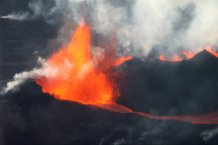Articles

The study used the 2014 Icelandic volcano eruption as a natural experiment
Cloud study demystifies impact of aerosols
Aerosol particles in the atmosphere have a bigger impact on cloud cover – but less effect on cloud brightness – than previously thought, new research shows.
Aerosols are tiny particles suspended in the atmosphere, and they play a key role in the formation of clouds.
With aerosols increasing due to human activities, numerous assessments by the Intergovernmental Panel on Climate Change (IPCC) have suggested they could have an important impact on climate change because clouds reflect sunlight and therefore keep temperatures cooler.
However, this cooling impact of aerosols on clouds is difficult to measure, and this has led to significant uncertainty climate change projections.
The new study – led by the University of Exeter, with national and international academic partners and the UK’s Met Office – used the 2014 Icelandic volcano eruption to investigate this.
"This massive aerosol plume in an otherwise near-pristine environment provided an ideal natural experiment to quantify cloud responses to aerosol changes, namely the aerosol’s fingerprint on clouds" said lead author Dr Ying Chen.
"Our analysis shows that aerosols from the eruption increased cloud cover by approximately 10%.
"Based on these findings, we can see that more than 60% of the climate cooling effect of cloud-aerosol interactions is caused by increased cloud cover.
"Volcanic aerosols also brightened clouds by reducing water droplet size, but this had a significantly smaller impact than cloud-cover changes in reflecting solar radiation."
Previous models and observations suggested this brightening accounted for the majority of the cooling caused by cloud-aerosol interactions.
Water droplets usually form in the atmosphere around aerosol particles, so a higher concentration of these particles makes it easier for cloud droplets to form.
However, as these cloud droplets are smaller and more numerous, the resulting clouds can hold more water before rainfall occurs – so, more aerosols in the atmosphere can lead to more cloud cover but less rain.
The study used satellite data and computer learning to study cloud cover and brightness.
It used 20 years of satellite cloud images from two different satellite platforms from the region to compare the periods before and after the volcano eruption.
The findings will provide observational evidence of aerosols' climate impacts to improve the models used by scientists to predict climate change.
Jim Haywood, Professor of Atmospheric Science at the University of Exeter and part of the Global Systems Institute, and a Met Office Research Fellow, said: "Our earlier work had showed that model simulations could be used to disentangle the relative contribution of aerosol-cloud-climate impacts and potentially confounding meteorological variability.
"This work is radically different as it does not rely on models; it uses state-of-the-art machine learning techniques applied to satellite observations to simulate what the cloud would look like in the absence of the aerosols.
"Clear differences are observed between the predicted and observed cloud properties which can be used to assess aerosol-cloud-climate impacts."
The study was funded by the Natural Environment Research Council (NERC) through the ADVANCE project, and the EU's Horizon 2020 research and innovation programme under the CONSTRAIN grant.
The paper, published in the journal Nature Geoscience, is entitled: "Machine-learning reveals climate forcing from aerosols is dominated by increased cloud cover."
Date: 1 August 2022
